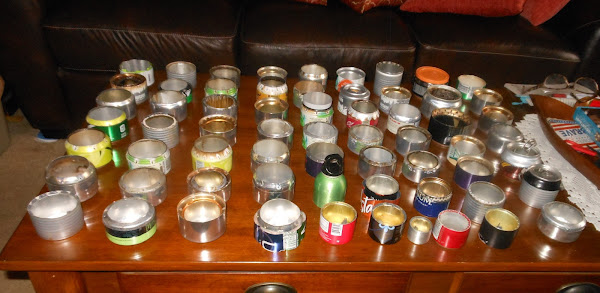Stoves Using Alcohol for Fuel
If you are Alc Stove bonkers your coffee table might look like the above picture. No, really.
Seriously, I've learned a lot about Alc hiking stoves. Their light weight, simplicity, and ease of making one from things found in almost any trash can appeals to me. I've probably made a 100 different designs and maybe a 1000 stoves in the last 15 years. It keeps my hands busy in the evenings.
OK, those 2 pictures were just to get your attention. Let me tell you about my last two stoves and a little about how to cook with an Alc stove. Regulating the heat is the hardest part. Not to mention if you are in high or cold country where Alcohol doesn't fume as easily. But we'll get to the high/cold conditions a little later.
First let me tell you about these 2 stoves that are nearly exactly alike. Except one has a bit of household pink wall insulation in the gas chamber that wicks some alcohol up the sides of the stove. That causes the fire to gasify that alcohol much faster. That make the stove bloom faster and burn hotter with a much bigger fire....maybe twice as big. See if you can tell which stove has the insulation in it.
I can't really explain why that stove burn yellowish when it burns the hottest, but it's not sooty or dirty like yellow flames can be. No Doubt you see the left hand stove burned much hotter. Except for boiling water that stove burn too hot. That stove is also good for high altitude and cold temperatrues, because in both those cases Alcohol doesn't fume as well and that is what does the actual burning. The hotter stove burned its 1/2 oz of Alcohol in about 4 minutes, where the right hand stove burned for a bit over 10 minutes.
When the hotter stove on the left is running low on fuel it burn clean blue and only about as hot as the right hand stove.
When the right hand stove is burning it's hotest after about 3 minutes, it burns almost as hot as the other stove.
You saw the stove on the right was a nice blue flame which eventually almost was as big a flame as the other stove once it heated up and caused the Alcohol to fume more. That's a great flame for general cooking. The left hand stove boils a cup of water in half the time as the right hand stove.
Both stoves are too hot to cook food with once it's started your pot boiling, but both those stoves can be controled by putting a plate on top with a 7/8" to 1.5" hole in the middle to make all that flame come out that middle hole. That causes the stove to cool down in 15 seconds or so and the flame will simmer your food depending on the size hole that is in the plate that you use. I recommend 3 plates with different sized holes, a 7/8, a 1", and a 1.25" hole. Here are a couple examples in the below picture. One is made from a 24oz soda can and the other is made from a flat piece of Aluminun.
Here the stove is with a simmer plate in action. I have simmered dry Pinto beans for 2.5 hrs with these simmer plates. I've baked a potato. I've cooked rice. I've even baked bread. It just take a little practise.
To build these stove I used a small catfood can. The kind that flares outward at the top. That outside flare diameter is a pressfit into a soda or beer can.
I make a big hole in the bottom of the catfood can that leave 1/4" shoulder arond the can's bottom. Then I file the can's top edge down so that I can remove the inside rim. That allows me to drill 12ea .050" holes in the can just below the outside rim, from the outside, up and into the can.
Now that catfood can is ready to shove down inside the soda can. First though, I made a 5/16" wide circle of soda can material that fits in the deepest part of the bottom of the soda can. Now I press the cat food can into the soda can until it touches the 5/16" piece of Al. Now you're ready to boil water. It's best to have a minimum space (nothing at all) between the catfood can and the 5/16" spacer.
I hope this helps someone with the camp cooking needs. Good luck.






Comments
Post a Comment